| Ambassador of Iran to Iraq | |
|---|---|
| Coat of Arms of Iran | |
| Inaugural holder | Hassan Ali Kamal Hedayat |
| Formation | 1931 |
The Iranian ambassador in Baghdad is the official representative of the Government in Tehran to the Government of Iraq.
| Ambassador of Iran to Iraq | |
|---|---|
| Coat of Arms of Iran | |
| Inaugural holder | Hassan Ali Kamal Hedayat |
| Formation | 1931 |
The Iranian ambassador in Baghdad is the official representative of the Government in Tehran to the Government of Iraq.
| Diplomatic accreditation | Diplomatic accreditation Solar Hijri calendar | Ambassador | Persian language | Observations | List of presidents of Iran | List of prime ministers of Iraq | Term end | Term end Solar Hijri calendar |
|---|---|---|---|---|---|---|---|---|
| 1931 | 1309 | Hassan Ali Kamal Hedayat | Persian : حسنعلی کمال هدایت |  | Reza Shah | Nuri al-Said | 1929 | 1307 |
| 1931 | 1309 | Taqi Nabavi | Persian : تقی نبوی | Muazziz-ud-Dauleb, Mohammed Taqi Nabavi (Moazid-ud-Dowleh) (F.O. 150; M.A. 188) to be Persian Minister to Czechoslovakia. He is father-in-law to Abul Hasan Ibtehaj, Governor of the Banque-i-Milli. | Reza Shah | Nuri al-Said | 1933 | 1311 |
| 1933 | 1311 | Bagher Kazemi | Persian : باقر کاظمی | Reza Shah | Jamil al-Midfai | 1934 | 1312 | |
| 1934 | 1312 | Anajat-ollah Samii | Persian : عنایتالله سمیعی | Enayatollah Sami'i, From February 1932 to 1934 he was Iranian ambassador to Germany. The new Persian Minister to Iraq, Sami Khan, arrived in Baghdad in December from Berlin, where he has been Persian Minister for a few years. Sami Khan was Persian Minister in Iraq in 1928, when the first Iraqi-Persian treaty was signed. [2] | Reza Shah | Ali Jawdat al-Aiyubi | 1937 | 1315 |
| 1937 | 1315 | Mozaffar Alam | Persian : مظفر اعلم | [3] | Reza Shah | Jamil al-Midfai | 1939 | 1317 |
| 1941 | 1319 | Abol Qassem Nadschm | Persian : ابوالقاسم نجم | Mohammad Reza Pahlavi | Jamil al-Midfai | 1941 | 1319 | |
| 1942 | 1320 | Musa Nuri Esfandiari | Persian : موسی نوری اسفندیاری | [4] | Mohammad Reza Pahlavi | Nuri al-Said | 1944 | 1322 |
| 1944 | 1322 | Mohsen Rais | Persian : محسن رئیس | Mohammad Reza Pahlavi | Hamdi al-Pachachi | 1948 | 1326 | |
| 1949 | 1327 | Mohammad Shayesteh | Persian : محمد شایسته | From February 7, 1940 /February 13, 1940 to November 19, 1945 he was Iranian ambassador to the United States | Mohammad Reza Pahlavi | Muzahim al-Pachachi | 1951 | 1329 |
| 1951 | 1329 | Mahmud Salahi | Persian : محمود صلاحی | Mohammad Reza Pahlavi | Nuri al-Said | 1952 | 1330 | |
| 1952 | 1330 | Hossein Ghods-Nakhai | Persian : حسین قدس نخعی | Mohammad Reza Pahlavi | Mustafa Mahmud al-Umari | 1953 | 1331 | |
| 1954 | 1332 | Mozaffar Alam | Persian : مظفر اعلم | Mohammad Reza Pahlavi | Nuri al-Said | 1954 | 1332 | |
| 1954 | 1332 | Hossein Ghods-Nakhai | Persian : حسین قدس نخعی | Mohammad Reza Pahlavi | Nuri al-Said | 1957 | 1335 | |
| 1957 | 1335 | Nader Batmanghelidj | Persian : نادر باتمانقلیچ | Major General | Mohammad Reza Pahlavi | Ali Jawdat al-Aiyubi | 1959 | 1337 |
| 1959 | 1337 | Amanullah Ardalan | Persian : برادران اردلان | Ardalan, Amanullah (Haji Izz-uI-Mamalik) Born about 1888. [5] | Mohammad Reza Pahlavi | Abd al-Karim Qasim | 1961 | 1339 |
| 1961 | 1339 | Yadollah Azodi | Persian : یدالله عضدی | Mohammad Reza Pahlavi | Abd al-Karim Qasim | 1961 | 1339 | |
| 1961 | 1339 | Abbas Aram | Persian : غلامعباس آرام | Mohammad Reza Pahlavi | Abd al-Karim Qasim | 1963 | 1341 | |
| 1963 | 1341 | Mohammad Hossein Mashayekh Faridani | Persian : محمدحسین مشایخ فریدنی | Doctor In 1961 he was Iranian ambassador to Saudi Arabia [6] | Mohammad Reza Pahlavi | Ahmed Hassan al-Bakr | 1965 | 1343 |
| 1965 | 1343 | Seid-Mehdi Pirasteh | Persian : سید مهدی پیراسته | 1962-1972 he was Iranian ambassador to Belgium [7] | Mohammad Reza Pahlavi | Abd al-Rahman al-Bazzaz | 1968 | 1346 |
| 1968 | 1346 | Ezatullah Ameli | Persian : عزتالله عاملی | Jan 24, 1970 - TEHRAN The Iranian Ambassador to Baghdad, Ezatullah Ameli, who was asked to leave the country immediately by the Government of Iraq, arrived in Tehran from Baghdad by plane the night before. [8] | Mohammad Reza Pahlavi | Ahmed Hassan al-Bakr | January 24, 1970 | 1348 |
| 1970 | 1348 | Majid Mehran | Persian : مجید کامران | Chargé d'affaires [9] | Mohammad Reza Pahlavi | Ahmed Hassan al-Bakr | 1972 | 1350 |
| 1974 | 1352 | Hossein Shahidzadeh | Persian : حسین شهیدزاده | (* 1922 in Qom Diplomat and Painter. Graduated from the Tehran University, Doctorate in Political science from the University of Neuchâtel. Fifth Political Department in Foreign Ministry (1971–74); Promote in the Rank of Ambassador in 1972; Iranian Ambassador to Baghdad (1974); Painter of the religious subjects (Exhibition, November 1973, Tehran) [10] | Mohammad Reza Pahlavi | Ahmad Hasan al-Bakr | 1977 | 1355 |
| 1977 | 1355 | Mir Sadegh Sadrieh | Persian : میرصادق صدریه | Sadegh Sadrieh (Persian: میرصادق صدریه; (2 February 1925 – 5 November 2009) was a prominent Iranian politician and diplomat who served as Foreign Ministry Office Counselor and as Ambassador during the Pahlavi era | Mohammad Reza Pahlavi | Ahmad Hasan al-Bakr | 1979 | 1357 |
| 1979 | 1357 | Fereydoun Adamyat | Persian : فریدون زندفرد | Mohammad Reza Pahlavi | Saddam Hussein | 1979 | 1357 | |
| 1979 | 1357 | Seyyed Mahmoud Doaei | Persian : سید محمود دعایی | Chargé d'affaires [11] | Mohammad Reza Pahlavi | Saddam Hussein | 1981 | 1359 |
| September 22, 1980 | 1358 | Interruption of the diplomatic relation due to the Iran–Iraq War, the Protecting power was Turkey | Abolhassan Banisadr | Saddam Hussein | August 20, 1988 | 1366 | ||
| October 1, 1988 | 1366 | Coalition Provisional Authority | Ali Khamenei | Saddam Hussein | ||||
| 2005 | 1385 | Hassan Kazemi Qomi | Persian : حسن کاظمی قمی | Mahmoud Ahmadinejad | Ibrahim al-Dschafari | 2010 | 1389 | |
| 2017 | 1389 | Hassan Danaeifar | Persian : حسن داناییفر | Mahmoud Ahmadinejad | Nouri al-Maliki | 2017 | 1395 | |
| April 18, 2017 | 1395 | Iraj Masjedi | Persian : ایرج مسجدی | Hassan Rouhani | Haider al-Abadi | April 11, 2022 | 1401 | |
| May 17, 2022 | 1401 | Mohammad-Kazem Al-e Sadegh | Persian : محمدکاظم آل صادق | Ebrahim Raisi | Mustafa Al-Kadhimi |

The Iran–Iraq War, also known as the First (Persian) Gulf War, was an armed conflict between Iran and Iraq that lasted from September 1980 to August 1988. Active hostilities began with the Iraqi invasion of Iran and lasted for nearly eight years, until the acceptance of United Nations Security Council Resolution 598 by both sides. Iraq's primary rationale for the attack against Iran cited the need to prevent Ruhollah Khomeini—who had spearheaded the Iranian Revolution in 1979—from exporting the new Iranian ideology to Iraq. There were also fears among the Iraqi leadership of Saddam Hussein that Iran, a theocratic state with a population predominantly composed of Shia Muslims, would exploit sectarian tensions in Iraq by rallying Iraq's Shia majority against the Baʽathist government, which was officially secular and dominated by Sunni Muslims. Iraq also wished to replace Iran as the power player in the Persian Gulf, which was not seen as an achievable objective prior to the Islamic Revolution because of Pahlavi Iran's economic and military superiority as well as its close relationships with the United States and Israel.
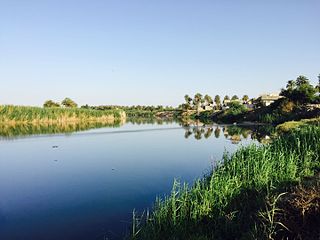
The Diyala is a river and tributary of the Tigris. It is formed by the confluence of the Sirwan and Tanjaro rivers in Darbandikhan Dam in the Sulaymaniyah Governorate of Northern Iraq. It covers a total distance of 445 km (277 mi).

The Ministry of Intelligence of the Islamic Republic of Iran is the primary intelligence agency of the Islamic Republic of Iran and a member of the Iran Intelligence Community. It is also known as VAJA and previously as VEVAK or alternatively MOIS. It was initially known as SAVAMA, after it took over the Shah's intelligence apparatus SAVAK. The ministry is one of the three "sovereign" ministerial bodies of Iran due to nature of its work at home and abroad.
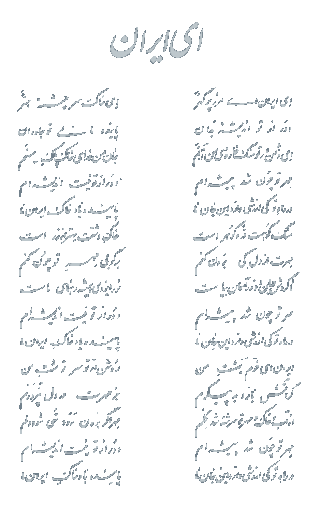
"Ey Irān" is an Iranian patriotic song that serves as the country's unofficial national anthem. The music was composed by Ruhollah Khaleqi, and the lyrics were written by Hossein Gol-e-Golab. This anthem was first performed by Gholam-Hossein Banan.
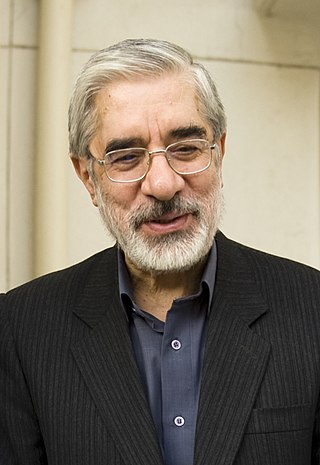
Mir-Hossein Mousavi Khameneh is an Iranian socialist politician, artist, architect and opposition figure who served as the 45th and last Prime Minister of Iran from 1981 to 1989. He was a reformist candidate for the 2009 presidential election and eventually the leader of the opposition in the post-election unrest. Mousavi served as the president of the Iranian Academy of Arts until 2009, when conservative authorities removed him. Although Mousavi had always considered himself a reformist and believed in promoting change within the 1979 constitution, on 3 February 2023, in response to the Mahsa Amini protests, he announced his opposition to the Islamic Republic and asked for a widespread referendum to fully change the constitution and make a fundamental change in Iran's political system.

Teymur Bakhtiar was an Iranian general and the founder and head of SAVAK from 1956 to 1961 when he was dismissed by the Shah. In 1970, SAVAK agents assassinated him in Iraq.

The Islamic Republican Party was formed in 1979 to assist the Iranian Revolution and Ayatollah Khomeini in their goal to establish theocracy in Iran. It was disbanded in 1987 due to internal conflicts.
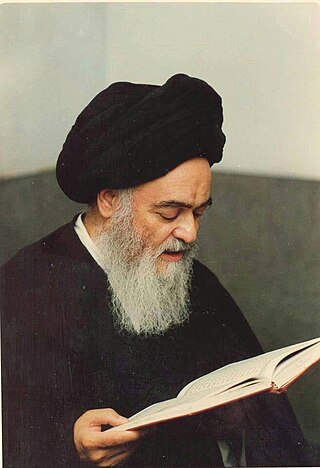
Grand Ayatollah Sayyid Muhammad al-Husayni al-Shirazi, commonly known as Imam Shirazi, was an Iranian-Iraqi Shia marja' and political activist.
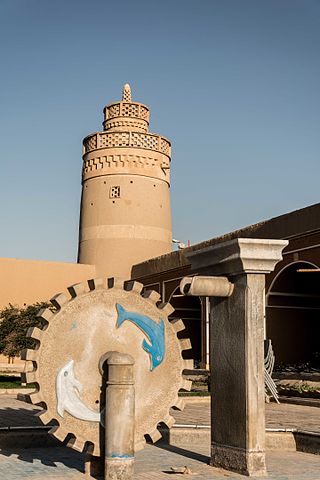
Najafabad is a city in the Central District of Najafabad County, Isfahan province, Iran, serving as capital of both the county and the district.
Hojatoleslam Sayyid Hussein Khomeini is an Iranian scholar and reformist cleric. He is the grandson of Grand Ayatollah Ruhollah Khomeini, the son of Ruhollah's first son, Mostafa Khomeini, and his wife, Masoumeh Haeri Yazdi, daughter of Morteza Haeri Yazdi.

Hussein, Hossein, Hussain, Hossain, Huseyn, Husayn, Husein, Hussin, Hoessein, or Husain, coming from the triconsonantal root Ḥ-S-N, is an Arabic name which is the diminutive of Hassan, meaning "good", "handsome" or "beautiful". It is commonly given as a male given name, particularly among Muslims. In Persian language contexts, the transliterations Ḥosayn, Hosayn, or Hossein are sometimes used. In the transliteration of Indo-Aryan languages, the forms "Hussain" or "Hossain" may be used. Other variants include Husên, Husejin, Husejn, Husain, Hisên, Hussain, Husayin, Hussayin, Hüseyin, Husseyin, Huseyn, Hossain, Hosein, Husseyn, Usain (etc.). The Encyclopaedia of Islam, which follows a standardized way for transliterating Arabic names, used the form "Ḥusain" in its first edition and "Ḥusayn" in its second and third editions.
Al Khadhraa is a neighborhood in Mansour district, western Baghdad, Iraq.

Camp Liberty is a former installation of the United States Department of Defense in Baghdad, Iraq. The installation was used from 2012 to September 2016 to house members of the People's Mujahedin of Iran, who had been forcibly evicted from Camp Ashraf.
On 23 April 2009, two separate suicide attacks occurred in Baghdad and Miqdadiyah. At least seventy-six people are known to have died in the attacks, including several Iranian pilgrims. The Los Angeles Times puts the death toll at seventy-nine. Most of the forty-eight people killed in Muqdadiyah, near Baqubah, Diyala Province, are believed to have been Iranian nationals. According to the BBC, if the death tolls are confirmed, these attacks were the most lethal of 2009.
Premiership of Mir-Hossein Mousavi were the third and fourth government of Iran after the Iranian Revolution. At that time, Ali Khamenei was the president.

In August 1981, President Mohammad-Ali Rajai and Prime Minister Mohammad-Javad Bahonar were assassinated in an explosion. Ali Khamenei was then elected as the third president of Iran in the October 1981 Iranian presidential election. He put forward Ali Akbar Velayati as his prime minister, but the Iranian parliament did not give him the vote of confidence, and he was defeated with a vote of 80 to 74. Subsequently, Ali Khamenei, though he had strong disagreements with Mousavi, as a compromise with the left-leaning parliament, agreed to offer him, Mousavi, for the post of premier. On 28 October, the parliament approved Mousavi with a vote of 115 to 39. Mousavi became the 79th Prime Minister of Iran on 31 October 1981, and remained the prime minister of Iran until 3 August 1989, for eight years.

The Qom Seminary is the largest Islamic seminary (hawza) in Iran, established in 1922 by Grand Ayatollah Abdul-Karim Haeri Yazdi in Qom. It trains Usuli scholars.
The Fath Medal is a military award of the Iranian armed forces which is awarded by Commander-in-chief, Supreme Leader of Iran. The medal is the likeness of three Palm leaves over Khorramshahr's grand mosque, Flag of Iran and the word "Fath".
Events from the year 1986 in Iran.
14th Imam Hossein Division is a division of the Islamic Revolutionary Guard Corps (IRGC).